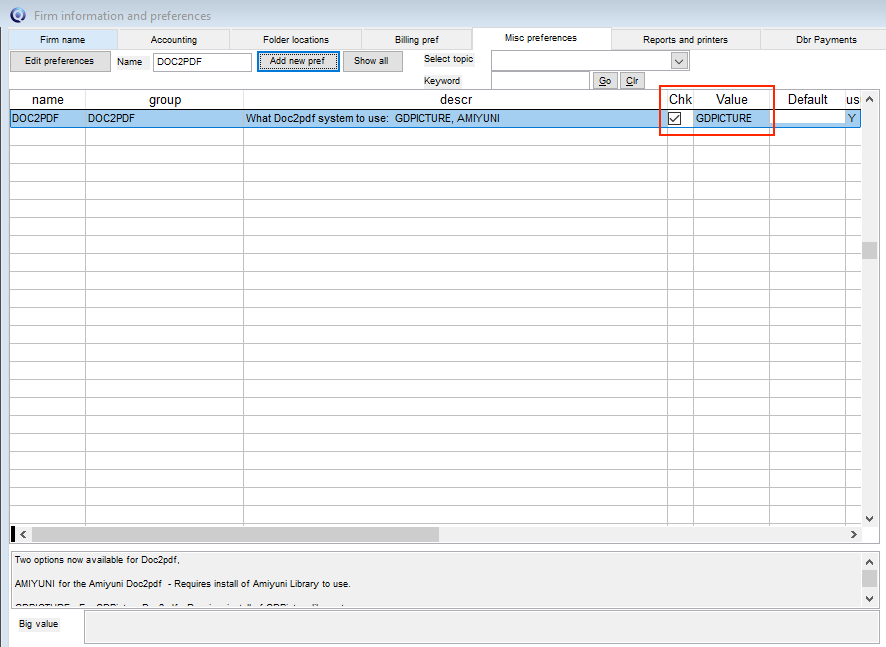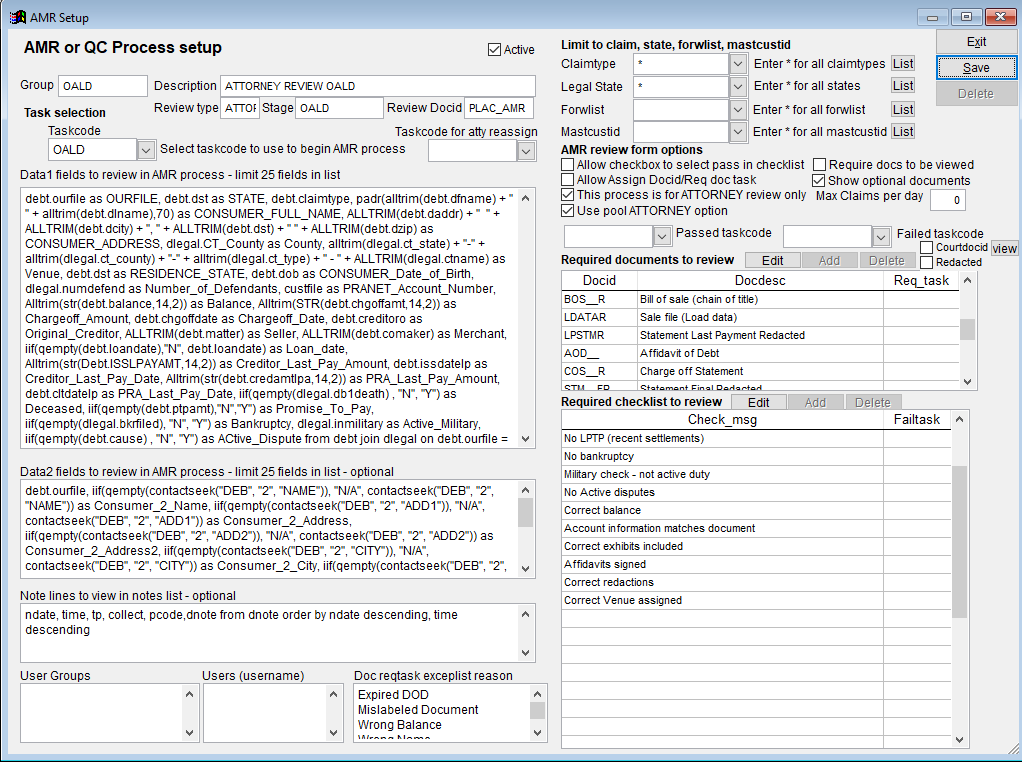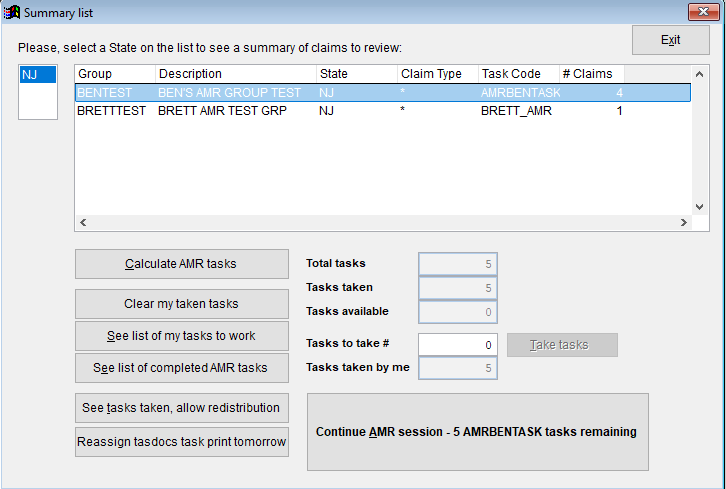Last Update: February 5, 2022
ATTORNEY MEANINGFUL REVIEW (AMR) SETUP
Table of Contents
Documents to include in AMR Group
Check list to include in AMR Group
Setup Firm preferences for AMR
See AMR work list for attorney user
Summary
- Define the AMR Group process for different claim stages, placement, suit, judgment, garnish, lien filing, and any other process to be user defined.
- Add tasks to claims for meaningful review for the AMR Group process.
- Allow attorneys who are licensed in a specific state to review claims for that state only. If a state has more than one licensed attorney, each attorney may select to review AMR for that process and state.
- The AMR screen is used for the review and may include check list of items to be checked off by the attorney, document DOCID’s required for that process and presentation of those documents from the claim.
- A PASS or FAIL selection for the purpose of passing or failing the review. If failed, allow attorney to notate the reason.
- An AMR Log is recorded showing each PASS, FAIL or CANCEL review by attorney, date, and time started. Optionally the system can also capture the review end time and the duration of review in seconds. If this is not activated in the firm preference, this duration is NOT captured and cannot be produced on demand.
Setup
Before beginning to utilize the AMR Claim Review Module, it must first be configured. This section will walk you through the various screens and necessary steps for its configuration.
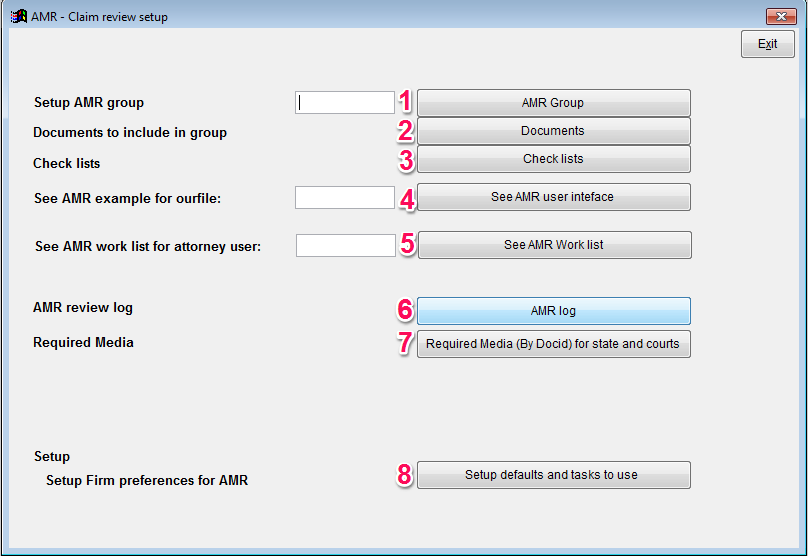
Setup AMR Group
This section allows the user to define the various stages that require Attorney Meaningful Review, such as Placement, Suit, Judgment, Garnishment and Lien filing. These stages can be configured to be unique to each state and claim type.
e.g. A generic claim placement may have differing criteria of what needs to be reviewed when compared to various other claim types, such as a credit card claim placement. That credit card claim placement may also require a different set of review criteria based on whether it was received by a firm in NJ or in MI.

AMR Setup Screen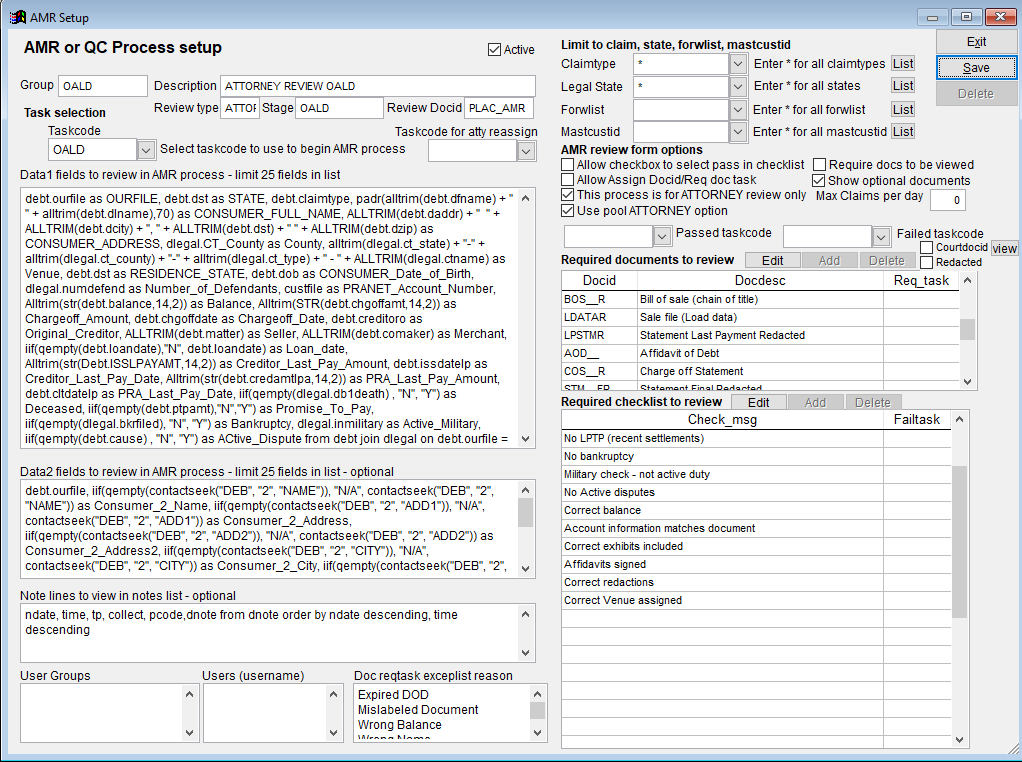
Fields
- Group
- This specifies the group that the type of review pertains to, such as Placement
- State
- This is the 2-character state abbreviation that will allow to further customize the specific rules used by the AMR Module. Leaving this field blank will indicates that the entry applies to ALL states.
- Claimtype
- Limit selection to certain claim types
- Descr
- Description of the AMR group
- Fields
- This is the default list of fields presented when starting the AMR review screen (Button “1”)
- This is a complete SQL select statement (not including the select key word) that will execute for this claim when the review screen prepares. Each table and field name is indicated here. The order of the fields is indicated by the select statement.
- Example placement statement:
debt.ourfile, debt.dst as state, debt.claimtype,debt.filetype, debt.collect as desk, debt.forwlist, debt.creditor as current_creditor, debt.creditoro as original_creditor, debt.comaker as tradename, custfile as creditor_acct_num, ncustfile as network_account, padr(alltrim(debt.dfname) + ” ” + alltrim(debt.dlname),70) as consumer_fullname, debt.dst as consumer_state, debt.dss as consumer_social, debt.dob as consumer_dob,debt.issdatelp as orig_cred_last_paid, debt.cltdatelp as cur_cred_last_paid, debt.loandate as Loan_service_date, chgoffdate as Charge_off_date, debt.assdate as Placed_date, str(debt.assd,14,2) as placed_amount, str(debt.princip,14,2) as principal, str(debt.interest,14,2) as Interest, str(debt.pint,7,2) as interest_rate, debt.datelp as last_interest_date, str(debt.attfee,14,2) as attorney_fees, str(debt.cost,14,2) as cost, str(debt.acharge,14,2) as misc_charge, str(debt.balance,14,2) as balance, debt.sol as sol_date from debt
- Fields2
- This is the additional data presented when the user clicks on the secondary tab of the AMR review screen (Button “2”)
- This is a complete SQL select statement (not including the select key word) that will execute for this claim when the review screen prepares. Each table and field name is indicated here. The order of the fields is indicated by the select statement.
- Example placement statement, tab 2:
debt.ourfile, dfname, dlname, daddr, dcity, dst, dzip, dss, dob from debt
- Example placement statement, tab 2:
- Notes1
- This field determines what will be shown on the paperless notes tab of the AMR review screen (Button “Note Hist”)
- This is a complete SQL select statement (not including the select key word) that will execute for this claim when the review screen prepares. Each table and field name is indicated here. The order of the fields is indicated by the select statement.
- Example for all notes:
ndate, time, tp, collect, dnote from dnote order by ndate descending, time descending
- Example for all notes:
- Checkall
- This field controls if the user will be presented with a single checkbox to approve all Validation check list items, or if they must approve each line item, one-by-one.
- If checked, the user will be presented with a single checkbox to approve all check list items.
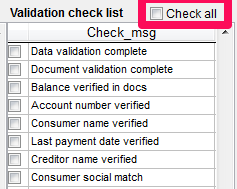
-
- If unchecked, the user will be required to approve each individual item in the check list, one-by-one.
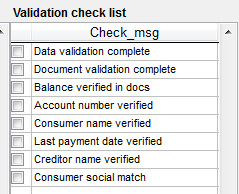
- Showdoci
- If your setup includes a list of required documents for this process, this should be checked, so that the user may click the “Req” checkbox in Required documents list to request this missing document. This also allows the user to identify and assign a docid to an unknown (unidentified) document in the claim document list.
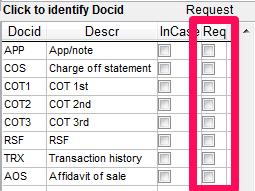
- Task1
- Task that Triggers AMR – added to claim to go into AMR
- Taskok
- Task triggers on Pass
- Taskerror
- Task triggers on Fail
- Att_use
- This check box is used to specify if the specified review can ONLY be performed by a licensed attorney or not. Leave unchecked if you wish to permit users or user groups indicated by usergroup name (see Usergroup parameter below) or a valid login username (see Users parameter below) to have access to this process.
- E.g. While the review for the filing of suit or judgment may require attorney involvement (check), the intake of new placements may be best suited for staff trained in those duties (unchecked).
- This check box is used to specify if the specified review can ONLY be performed by a licensed attorney or not. Leave unchecked if you wish to permit users or user groups indicated by usergroup name (see Usergroup parameter below) or a valid login username (see Users parameter below) to have access to this process.
- Poolatt
- When checked, any attorney licensed for that state may process the review. If unchecked, it is limited to the user assigned at debt.att
- Usergroup
- If Att_use checkbox is NOT checked, then you may enter a USERGROUP (membership of group code in userlist setup) and all active members of this group may be given access to this AMR group. Separate multiple groups by comma.
- AMR is only available if you are an attorney in a state with AMR tasks or if you are setup as user in AMR_GROUPS in maintenance.
- E.g. PARALEGALS, ATTORNEYS, Etc.
- If Att_use checkbox is NOT checked, then you may enter a USERGROUP (membership of group code in userlist setup) and all active members of this group may be given access to this AMR group. Separate multiple groups by comma.
- Users
- If Att_use checkbox is NOT checked, then you may enter a list of Users who may be given access to this AMR group. Separate multiple users by comma.
- E.g. KURTS, ADAMP, Etc.
- If Att_use checkbox is NOT checked, then you may enter a list of Users who may be given access to this AMR group. Separate multiple users by comma.
- Logfile
- Reserved for future use
- Courtdocid
- Check if the system should use the courtdocid table when determining required documents
- If checked, the system will use the Stage field in the AMR Setup to determine which Proctype to choose from the courtdocid table
- Check if the system should use the courtdocid table when determining required documents
- Redacted
- Check to use the redacted form of the document based on how the courtdocid table is setup
Documents to include in AMR Group
This section allows the user to define which documents (through the use of valid DOCID) are required to be present for the stages specified in Setup AMR Group. Not only can each stage have their own default required group of documents, but the required documentation can also be specified based on the type of claim.
It is important to note the following:
- “DOCID” is case-sensitive.
- If your setup includes a list of required documents for this process, then “Showdoci” should be checked in AMR-Groups.
Fields
- Qgroup
- The Qgroup must match one of the Qgroups specified in AMR-Groups
- Claimtype
- Indicates the specific claimtype the entry is applicable to be used for. An asterisk “*” indicates that entry is applicable to ALL claimtypes.
- Num
- This specifies the sort order used in which this list will be displayed.
- TIP: If importing the rules, use Excel to correctly sort the list prior to importing, this will allow for the fields to be imported and displayed in a logical order.
- Docid
- This is the Docid that the program will look for on the claim relating to a specific document.
- NOTE: This field is case-sensitive
- Docdesc
- This is a description of the document.
- NOTE: This description is used to update scanfile.docdesc if used to identify documents in claim.
- Req_task
- Request – task code will be added to the claim if the Media DOCID is not on account.
Check list to include in AMR Group
Used to show a checklist applicable to the AMR Groups for the attorney to check off as part of their review process.
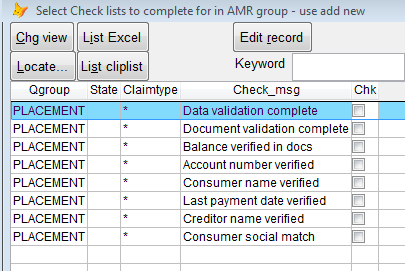
Fields
- Qgroup
- The Qgroup must match one of the Qgroups specified in AMR-Groups
- Claimtype
- Indicates the specific claimtype the entry is applicable to be used for. An asterisk “*” indicates that entry is applicable to ALL claimtypes.
- Check_msg
- This is the checklist message that will be displayed in the “Validation check list” section of the AMR claim review screen.
- Chk
- DO NOT USE! This field is for application use only and should remain unchecked.
Setup Firm preferences for AMR
Firm will be able to see Firm preferences pertaining to the AMR Module. To edit these preferences, user will need to go into Firm Preferences in Maintenance.
Available Firm Preferences:
- ID=AMR_TIME check this to include the ending time and duration in the log file
- ID=AMR A code will be provided by Vertican, Inc. to activate the AMR module on your system.
Attorney User Setup
The attorney must be setup with the licensed states in User settings under AttyID, Billing as shown below.
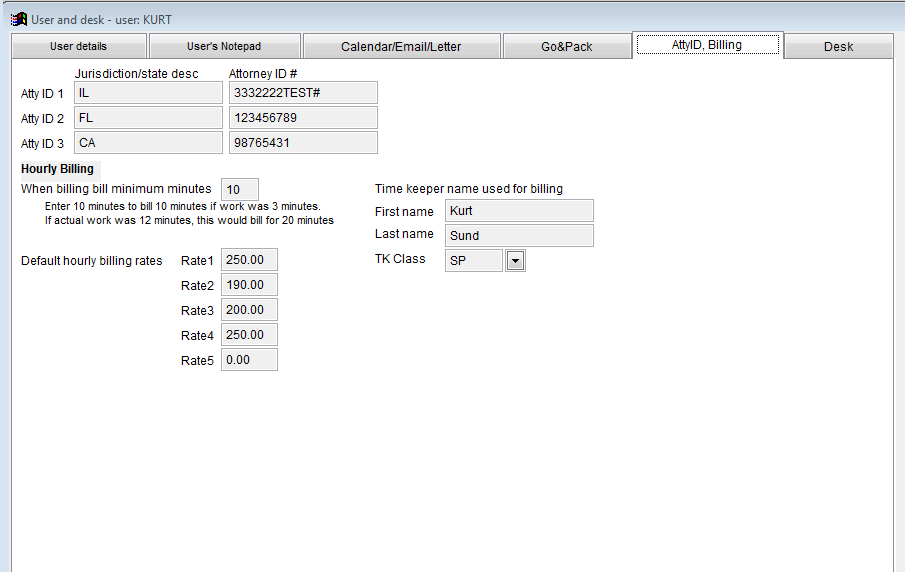
The licensed states will then appear in the Summary List if there are claims to review.
DDAS
DDAS is available to be triggered with: SYSTEM.AMR.
DDAS condition can check for AMR_GROUP = “PLACEMENT” and can check if passed or failed using MAMR_STATUS = ‘PASSED’ or ‘FAILED’.
A complete report is saved in the document manager.
See AMR example for ourfile
This is for Admin use to test or can be used if need be to expediently review a single claim on demand. To utilize:
- Select an AMR Group in option 1
- Input a valid ourfile
- Click on See AMR user interface
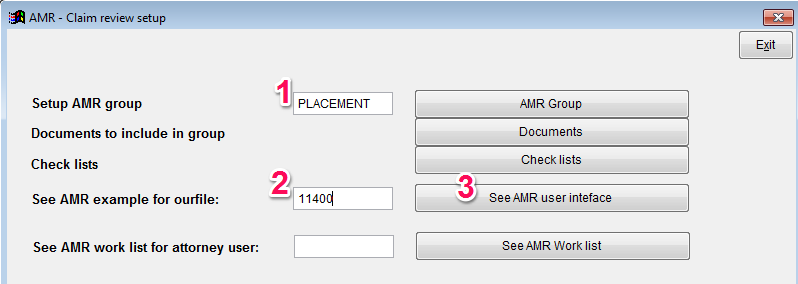
See AMR work list for attorney user
This is for Admin use to review the claims that are in the queue for a specified attorney for a specified AMR Group and specified State that the attorney is licensed in. Claims with a due date or task of today or earlier will be reported in a list to review.
1. Select an AMR Group in option 1
2. Input attorney user name
3. Click on See AMR Work list
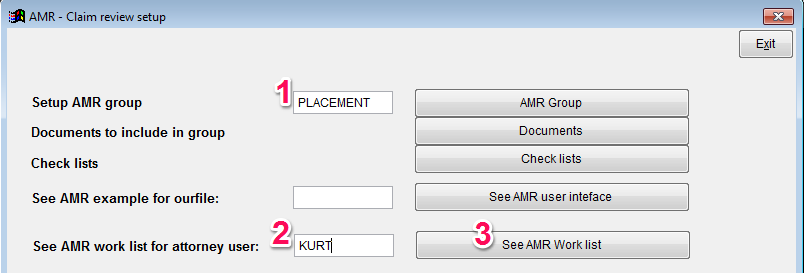
4. Select a state that the attorney is licensed in (based on userlist.attyiddes1 (2 or 3))

5. Once a state has been selected, all claims with the AMR Group Task added to the claims and with a due date or task of today or earlier will now appear in the list to review.
6. If no claims match the criteria specified, the following message will be received
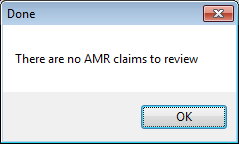
AMR Review log
Click to see the AMR review log that has been recorded.
Fields
- Amr_group
- The Amr_group is a unique code used to identify the AMR review group – Such as PLACEMENT, SUIT, JUDGMENT, Etc
- State
- The Legal State of claim
- Claimtype
- The type of debt that the claim is. E.g. Credit Card, Auto, Loan, etc., Need to match the debt.claimtype field in the claim.
- Username
- The user who performed the review
- Date
- The date the review was performed
- Btime
- The timestamp of when the review began
- Etime
- The timestamp of when the review ended (unless unchecked to record in firm pref id: AMR_TIME)
- Duration
- The total time in seconds spent on the review (unless unchecked to record in firm pref id: AMR_TIME)
- Pass_fail
- This will indicate the result of the review:
- PASS – all components of the review had passed
- FAIL – some or all components of the review did not pass. See Fail_note for details of why the review failed.
- CANCEL – the review was cancelled
- This will indicate the result of the review:
- Fail_note
- Notes entered by the user pertaining to why the review did not pass.
- Ourfile
- The internal file number of the claim
Enabling GDPicture
- Navigate to [Maintenance] > [System Admin-Maintenance] Tab > [Firm Preferences] > [Misc Preferences] Tab.
- Locate the preference “DOC2PDF”.
- When found:
- Check the box in the “Chk” column.
- Adjust the text in the “value” column to GDPICTURE if it’s not already set.
